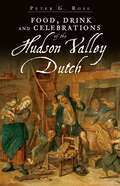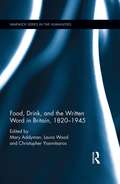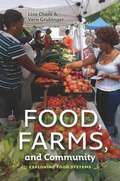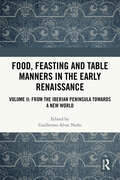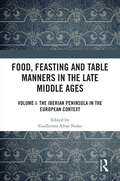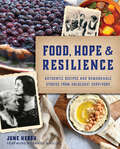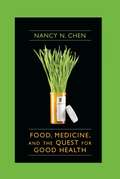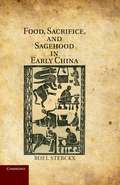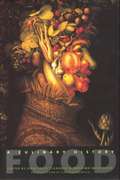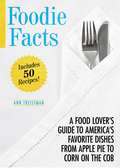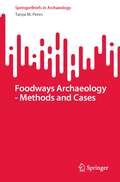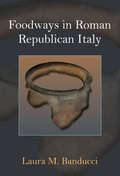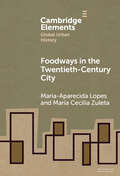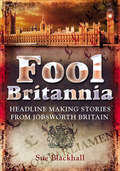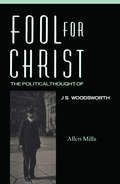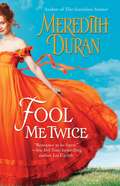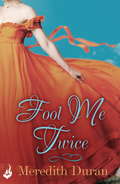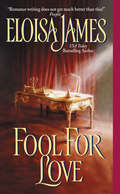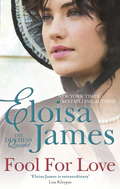- Table View
- List View
Food, Drink and Celebrations of the Hudson Valley Dutch (American Palate)
by Peter G RoseThe renowned food historian delves into the early culinary traditions of Dutch settlers in New York state and their influence on the American kitchen.In 1609, Henry Hudson, under contract with the Dutch East India Company, set out to discover the lucrative Northwest Passage. The Hudson River Valley is what he discovered instead, and along its banks Dutch culture took hold. While the Dutch influence can still be seen in local architecture and customs, it is food and drink that Peter Rose has made her life&’s work. From beer to bread and cookies to coleslaw, Food, Drink and Celebrations of the Hudson Valley Dutch is a comprehensive look at this important early American influence, complete with recipes to try.
Food, Drink, and the Written Word in Britain, 1820-1945 (Warwick Series in the Humanities)
by Laura Wood Mary Addyman Christopher YiannitsarosThis volume explores the intersection between culinary history and literature across a period of profound social and cultural change. Split into four parts, essays focus on the relationships between eating and childhood reading in the Victorian era, the role of hunger in depicting social instability and reform, the cultivation of taste through advertising and the formation of cultural legacies through imaginative and emotional experiences of food and drink. Contributors show that studying consumption is necessary for a full understanding of class, gender, national identity and the body. The works of writers such as Elizabeth Gaskell, Edward Lear, Isabella Beeton and Bram Stoker are considered alongside advice manuals, Home Front narratives and advertising to provide an innovative work that will be of interest to scholars of social, cultural and medical history as well as literary studies.
Food, Energy and the Creation of Industriousness
by Craig Muldrew"Until the widespread harnessing of machine energy, food was the energy which fuelled the economy. In this groundbreaking study of agricultural labourers' diet and material standard of living Craig Muldrew uses new empirical research to present a much fuller account of the interrelationship between consumption, living standards and work in the early modern English economy than has previously existed. The book integrates labourers into a study of the wider economy and engages with the history of food as an energy source and its importance to working life, the social complexity of family earnings and the concept of the 'industrious revolution'. It argues that 'industriousness' was as much the result of ideology and labour markets as labourers' household consumption. Linking this with ideas about the social order of early modern England the author demonstrates that bread, beer and meat were the petrol of this world and a springboard for economic change"--
Food, Farms, and Community: Exploring Food Systems
by Lisa Chase Vern GrubingerThroughout the United States, people are increasingly concerned about where their food comes from, how it is produced, and how its production affects individuals and their communities. The answers to these questions reveal a complex web of interactions. While large, distant farms and multinational companies dominate at national and global levels, innovative programs including farmers' markets, farm-to-school initiatives, and agritourism are forging stronger connections between people and food at local and regional levels. At all levels of the food system, energy use, climate change, food safety, and the maintenance of farmland for the future are critical considerations. The need to understand food systems--what they are, who's involved, and how they work (or don't)--has never been greater. Food, Farms, and Community: Exploring Food Systems takes an in-depth look at critical issues, successful programs, and challenges for improving food systems spanning a few miles to a few thousand miles. Case studies that delve into the values that drive farmers, food advocates, and food entrepreneurs are interwoven with analysis supported by the latest research. Examples of entrepreneurial farms and organizations working together to build sustainable food systems are relevant to the entire country--and reveal results that are about much more than fresh food.
Food, Feasting and Table Manners in the Early Renaissance: Volume II: From the Iberian Peninsula towards a New World
by Guillermo Alvar NuñoThe acquisition of table manners and rhetorical skills, the interaction between medicine and eating, and the presence of food in literature and religion shaped Peninsular societies and connected them to a Western European background during the Middle Ages. The Renaissance, however, marked a turning point in world history, and the reader will learn how eating evolved in the kingdoms of Spain and Portugal during the early Renaissance in fields such as morals, politics, medicine, literature and religion. The book also explains how the cultural conception of food was exported by Iberian explorers to the Americas and Japan.The present volume focuses on a two-fold issue: food as a cultural element that united Mediterranean European society, and food as a cultural encounter between European explorers and new worlds during the early Renaissance. Therefore, this volume continues the themes introduced in the previous monograph, Food, Feasting and Table Manners in the Late Middle Ages: Volume I: The Iberian Peninsula in the European Context, but takes into account the new, global scale of the era.Readers will find here a panorama of what, and how, people ate in Mediterranean Europe during the fifteenth and sixteenth centuries and learn how cultural aspects of food were exported to the new lands that were explored during the Age of Discovery.
Food, Feasting and Table Manners in the Late Middle Ages: Volume I: The Iberian Peninsula in the European Context
by Guillermo Alvar NuñoThis book offers a study of what and how people ate in the Iberian Peninsula between the twelfth and fifteenth centuries. It has long been recognized that Mediterranean cultures attach great importance to communal meals and food cooked with great refinement. However, whilst medieval feasting in England, France and Italy has been thoroughly studied, Spain and Portugal have both been somewhat neglected in this area of study. This volume analyses how medieval men of the Iberian Peninsula questioned themselves about different aspects deemed important in social feasting. It investigates the acquisition of table manners and rhetorical skills, the interaction between medicine and eating, and the presence of food in literature and religion. The book also shows how this shared society and culture, as well as their attitude towards food, connected them to a Western European tradition. The book will appeal to scholars and students alike interested in food and feasting from the perspectives of literature, history, language, art, religion and medicine, and to those interested in a social, cultural and literary overview of life in the Iberian Peninsula during the late Middle Ages.
Food, Feminism, and Women’s Art in 1970s Southern California (Routledge Research in Gender and Art)
by Emily Elizabeth GoodmanThis book explores how feminist artists continued to engage with kitchen culture and food practices in their work as women’s art moved from the margins to the mainstream. In particular, this book examines the use of food in the art practices of six women artists and collectives working in Southern California—a hotbed of feminist art in the 1970s—in conjunction with the Women’s Art Movement and broader feminist groups during the era of the Second Wave. Focused around particular articulations of food in culture, this book considers how feminist artists engage with issues of gender, labor, class, consumption, (re)production, domesticity, and sexuality in order to advocate for equality and social change. The book will be of interest to scholars working in art history, food studies, and gender and women’s studies.
Food, Feminism, and Women’s Art in 1970s Southern California (Routledge Research in Gender and Art)
by Emily Elizabeth GoodmanThis book explores how feminist artists continued to engage with kitchen culture and food practices in their work as women’s art moved from the margins to the mainstream.In particular, this book examines the use of food in the art practices of six women artists and collectives working in Southern California—a hotbed of feminist art in the 1970s—in conjunction with the Women’s Art Movement and broader feminist groups during the era of the Second Wave. Focused around particular articulations of food in culture, this book considers how feminist artists engage with issues of gender, labor, class, consumption, (re)production, domesticity, and sexuality in order to advocate for equality and social change.The book will be of interest to scholars working in art history, food studies, and gender and women’s studies.
Food, Hope & Resilience: Authentic Recipes and Remarkable Stories from Holocaust Survivors (American Palate)
by June HershCulinary Traditions Preserved, Stories Never to be Forgotten This vital collection of survivor stories uplifts and inspires alongside recipes that nourish your soul. Read about daring partisans who fought in the woods, hidden children who sought comfort from strangers and those who endured unimaginable internment. For Holocaust survivors, food was a way to connect their lives before the war with the homes they created after. Their kitchens were filled with the aromas of familiar foods like chicken soup and brisket while unfamiliar delights they adopted, like arroz con pollo and gnocchi, became part of their repertoire. These are the recipes they share with you. Culinary icons such as Michael Solomonov, Jonathan Waxman, Ina Garten and more contribute their own recipes as tribute to the remarkable survivor community. Author June Hersh gives readers a taste of history and a life-affirming message that honors the legacy of Holocaust survivors. A portion of the proceeds from sales of this book will benefit organizations committed to Holocaust education.
Food, Medicine, and the Quest for Good Health
by Chen Nancy N.Drawing on medical texts and food therapy practices from around the world and throughout history, Nancy N. Chen locates old and new crossovers between food and medicine in different social and cultural contexts.
Food, Medicine, and the Quest for Good Health: Nutrition, Medicine, and Culture
by Nancy ChenWhat we eat, how we eat, where we eat, and when we eat are deeply embedded cultural practices. Eating is also related to how we medicate. The multimillion-dollar diet industry offers advice on how to eat for a better body and longer life, and avoiding harmful foods (or choosing healthy ones) is considered separate from consuming medicine-another multimillion-dollar industry. In contrast, most traditional medical systems view food as inseparable from medicine and regard medicinal foods as the front line of healing. Drawing on medical texts and food therapy practices from around the world and throughout history, Nancy N. Chen locates old and new crossovers between food and medicine in different social and cultural contexts. The consumption of spices, sugar, and salt was once linked to specific healing properties, and trade in these commodities transformed not just the political economy of Europe, Asia, and the New World but local tastes and food practices as well. Today's technologies are rapidly changing traditional attitudes toward food, enabling the cultivation of new admixtures, such as nutraceuticals and genetically modified food, that link food to medicine in novel ways. Chen considers these developments against the evolving food regimes of the diet industry in order to build a framework for understanding diet as individual practice, social prescription, and political formation.
Food, Sacrifice, and Sagehood in Early China
by Roel SterckxIn ancient China, the preparation of food and the offering up of food as a religious sacrifice were intimately connected with models of sagehood and ideas of self-cultivation and morality. Drawing on received and newly excavated written sources, Roel Sterckx's book explores how this vibrant culture influenced the ways in which the early Chinese explained the workings of the human senses, and the role of sensory experience in communicating with the spirit world. The book, which begins with a survey of dietary culture from the Zhou to the Han, offers intriguing insights into the ritual preparation of food - some butchers and cooks were highly regarded and would rise to positions of influence as a result of their culinary skills - and the sacrificial ceremony itself. As a major contribution to the study of early China and to the development of philosophical thought, the book will be essential reading for students of the period, and for anyone interested in ritual and religion in the ancient world.
Food: A Culinary History
by Jean-Louis Flandrin Massimo Montanari Albert SonnenfeldWhen did we first serve meals at regular hours? Why did we begin using individual plates and utensils to eat? When did "cuisine" become a concept and how did we come to judge food by its method of preparation, manner of consumption, and gastronomic merit?Food: A Culinary History explores culinary evolution and eating habits from prehistoric times to the present, offering surprising insights into our social and agricultural practices, religious beliefs, and most unreflected habits. The volume dispels myths such as the tale that Marco Polo brought pasta to Europe from China, that the original recipe for chocolate contained chili instead of sugar, and more. As it builds its history, the text also reveals the dietary rules of the ancient Hebrews, the contributions of Arabic cookery to European cuisine, the table etiquette of the Middle Ages, and the evolution of beverage styles in early America. It concludes with a discussion on the McDonaldization of food and growing popularity of foreign foods today.
Food: A Culinary History (European Perspectives: A Series in Social Thought and Cultural Criticism)
by Montanari Massimo Flandrin Jean-LouisWhen did we first serve meals at regular hours? Why did we begin using individual plates and utensils to eat? When did "cuisine" become a concept and how did we come to judge food by its method of preparation, manner of consumption, and gastronomic merit?Food: A Culinary History explores culinary evolution and eating habits from prehistoric times to the present, offering surprising insights into our social and agricultural practices, religious beliefs, and most unreflected habits. The volume dispels myths such as the tale that Marco Polo brought pasta to Europe from China, that the original recipe for chocolate contained chili instead of sugar, and more. As it builds its history, the text also reveals the dietary rules of the ancient Hebrews, the contributions of Arabic cookery to European cuisine, the table etiquette of the Middle Ages, and the evolution of beverage styles in early America. It concludes with a discussion on the McDonaldization of food and growing popularity of foreign foods today.
Foodie Facts: A Food Lover's Guide to America's Favorite Dishes from Apple Pie to Corn on the Cob
by Ann TreistmanConsider this The Food Lover's Companion lite-short and sweet trivia about retro American food.Who pitted the first cherries and nestled them into pie crust? Was a meatloaf sandwich the result of a late-night refrigerator run? And does anyone really crave green bean casserole, complete with fried onions on top?In this time of hyperawareness of locality-when every roast chicken needs a pedigree of a free-range home and antibiotic-free past-it's time to celebrate the very basics of American cooking, the joy of Velveeta and pleasures of Jell-O.In this fun collection, author Ann Treistman takes readers on a journey through a 1950s kitchen, sometimes with surprising results. For example, deviled eggs were first prepared in ancient Rome, in a slightly different form and without the familiar moniker. The practice of removing the yolks from hard-boiled eggs, mixing it with spices and refilling the shells was fairly common by the 1600s. Why the devil? Well, it's hot in hell, and by the eighteenth century, it was all the rage to devil any food with a good dose of spice. Adding mustard or a signature sprinkle of hot paprika turned these eggs into devils.The perfect gift for those who love to make, bake, and eat food, Foodie Facts promises to be a wickedly good read with recipes to boot.
Foodways Archaeology - Methods and Cases (SpringerBriefs in Archaeology)
by Tanya M. PeresThis volume presents an overview of methodologies to identify and study foodways in the archaeological record. It also includes definitions, information, and examples for students and professionals to understand the basic analytical approaches, methods, and themes critical to archaeological studies of foodways. One of the main goals of this book is to show that foodways can help us better understand many aspects of a culture and can be studied from the material culture recovered from archaeological sites. It is important to stress that foodways are, and should be, studied by more than zooarchaeologists and paleoethnobotanists. Foodways encompass the biological and cultural need for sustenance, and thus are a research area that incorporates a multitude of artifact types, analytical specialties, and research questions.Foodways are a tangled web of ideas and behaviors that structure diet, subsistence strategies, cuisines, and the use of food to express identity. While foodstuffs are primary components to foodways, the consumption of material foods is inherently social. Food, dishes, and cuisines are expressions of the people, culture, and time in which they are created. Foodways Archaeology is devoted specifically to the archaeological study of the intersection of food, culture, history, and traditions as viewed in the archaeological record.
Foodways in Roman Republican Italy
by Laura M. BanducciFoodways in Roman Republican Italy explores the production, preparation, and consumption of food and drink in Republican Italy to illuminate the nature of cultural change during this period. Traditionally, studies of the cultural effects of Roman contact and conquest have focused on observing changes in the public realm: that is, changing urban organization and landscape, and monumental construction. Foodways studies reach into the domestic realm: How do the daily behaviors of individuals express their personal identity, and How does this relate to changes and expressions of identity in broader society? Laura M. Banducci tracks through time the foodways of three sites in Etruria from about the third century BCE to the first century CE: Populonia, Musarna, and Cetamura del Chianti. All were established Etruscan sites that came under Roman political control over the course of the third and second centuries BCE. The book examines the morphology and use wear of ceramics used for cooking, preparing, and serving food in order to deduce cooking methods and the types of foods being prepared and consumed. Change in domestic behaviors was gradual and regionally varied, depending on local social and environmental conditions, shaping rather than responding to an explicitly “Roman” presence.
Foodways in the Twentieth-Century City (Elements in Global Urban History)
by Maria-Aparecida Lopes María Cecilia ZuletaFoodways in the Twentieth-Century City explores a fundamental question through the lens of the modern metropolis: How did the experience of food and eating evolve throughout the twentieth century? In answering this query, this Element examines significant changes in the production, distribution, and consumption of food in cities worldwide. It takes a comprehensive view of foodways, encompassing the material, institutional, and sociocultural conditions that shaped food's journey from farm to table. The work delves into everyday practices like buying, selling, cooking, and eating, both at home and in public spaces. Central themes include local and global food governance and food access inequality as urban communities, markets, and governments navigated the complex landscape of abundance and scarcity. This Element highlights the unique dynamics of food supply and consumption over time.
Fool Britannia: Headline Making Stories from Jobsworth Britain
by Sue BlackhallFrom annoying work speak to bureaucratic blunders, a hilarious account of political correctness and pedantry run amok across the pond. Shoppers barred because they don&’t fit the bill, motorists targeted while real villains win the day, health and safety becoming a sick joke, and Big Brother putting a dampener on our freedom, fun, and fancies. Yes, Britain has become so politically correct that just about everything someone does is criminal. The &“Thought Police&” that blight every institution—ranging from education and energy to councils and churches—now have such a rigid rule book that everyday living is a hazard to us all. Does it all make you so irate that you want to flee? Or do you just laugh off the eccentricities that are forever England? (Oh, and Ireland, Scotland, and Wales too!). In this book we have compiled the headline-hitting harassment of ordinary folk over the year. We hope you can see the funny side of a &“Credit Crunch&” country that is suffering from &“Credibility Crunch&” as well. Some tales are pitiful, some petty, and some just downright pedantic—but all all echo to the refrains of Fool Britannia . . .
Fool Britannia: Headline Making Stories from Jobsworth Britain
by Sue BlackhallFrom annoying work speak to bureaucratic blunders, a hilarious account of political correctness and pedantry run amok across the pond. Shoppers barred because they don&’t fit the bill, motorists targeted while real villains win the day, health and safety becoming a sick joke, and Big Brother putting a dampener on our freedom, fun, and fancies. Yes, Britain has become so politically correct that just about everything someone does is criminal. The &“Thought Police&” that blight every institution—ranging from education and energy to councils and churches—now have such a rigid rule book that everyday living is a hazard to us all. Does it all make you so irate that you want to flee? Or do you just laugh off the eccentricities that are forever England? (Oh, and Ireland, Scotland, and Wales too!). In this book we have compiled the headline-hitting harassment of ordinary folk over the year. We hope you can see the funny side of a &“Credit Crunch&” country that is suffering from &“Credibility Crunch&” as well. Some tales are pitiful, some petty, and some just downright pedantic—but all all echo to the refrains of Fool Britannia . . .
Fool For Christ
by Allen MillsJames Shaver Woodsworth (1874-1942) stands as one of the half-dozen most important national political figures in twentieth-century Canadian history. Allen Mills acknowledges his outstanding achievements while providing a critical account of the Woodsworth legacy and revising the received opinion of him as a man of unbending conviction and ever-coherent principle.A product of western Canada's pioneer society and a stern Methodist household, Woodsworth grew up to make his way into social service and politcal action. A member of parliament for over twenty years, he rejected the traditional forms of political activity, seeking a new politics and a new political party. The latter turned out to be the Co-operative Commonwealth Federation founded in 1932. Its first leader was Woodsworth himself.In a crucial period between the World Wars, Woodsworth helped define the character of the modern Canadian, non-Marxist Left and of many of Canada's important economic and social institutions. Among them are the welfare state, the Bank of Canada, and Canada's internationalist role in the contemporary world. Disclaimer: Quotes by T.S. Eliot, F.R. Scott, and Louis MacNeice removed at the request of the rights holder.
Fool Me Twice (Rules for the Reckless #2)
by Meredith DuranIn the vein of Sarah MacLean, a sexy and evocative Regency romance between a vengeful duke and a fiery redhead from an author who is a veritable tour de force in the genre. &“Readers need to make room on their keeper shelf for Meredith Duran&” (Fresh Fiction).A lady with a secret. Running for her life, exhausted and out of options, Olivia Holladay wants nothing more than the chance to make a home for herself. So when she realizes that the infamous Duke of Marwick might hold the key to her freedom, she boldly disguises herself as the newest and bravest in a long line of the duke&’s notoriously temperamental housekeepers. Little does she know that the wickedly handsome Alastair de Grey has very different plans for her. A man with a passion—for vengeance. As his new employee, Olivia is a fearless upstart. As a woman, the daring redhead is just what Alastair needs to rouse him from darkness to the siren call of revenge. He has suffered a betrayal so deep that he will use whatever means necessary to destroy his enemies—even his brazen and beautiful domestic. But his vengeful plan fails to account for his single weakness: an irresistible and growing passion for the enigmatic Olivia.
Fool Me Twice: Rules for the Reckless 2 (Rules for the Reckless #3)
by Meredith DuranMeredith Duran returns with another witty, humorous and smart romance in the second book of her Rules for the Reckless series, and winner of the 2015 RITA for Historical Fiction. Fans of Julia Quinn, Jane Feather and Eloisa James will delight in Meredith's trademark headstrong heroine, cunning hero and tale of deep emotional intensity!Sensible and lonely, Olivia Mather survives by her wits - and her strict policy of avoiding trouble. But when she realises that the Duke of Marwick might hold the secrets of her family's past, she does the unthinkable, infiltrating his household as a maid. She'll clean his study and rifle through his papers looking for information.Alastair de Grey has a single reason to live: vengeance. More beautiful than Lucifer, twice as feared, and thrice as cunning, he'll use any weapon to punish those who fooled and betrayed him - even an impertinent maid who doesn't know her place. But the more fascinated he becomes with the uppity redhead, the more dangerous his carefully designed plot becomes. For the one contingency he forgot to plan for was falling in love...and he cannot survive being fooled again.Want more Rules for the Reckless? Don't miss Your Wicked Heart or That Scandalous Summer.
Fool for Love (Duchess in Love #2)
by Eloisa JamesThe WomanLady Henrietta Maclellan longs for the romantic swirl of a London season. But as a rusticating country maiden, she has always kept her sensuous nature firmly under wraps -- until she meets Simon Darby. Simon makes her want to whisper promises late at night, exchange kisses on a balcony, receive illicit love notes. So Henrietta lets her imagination soar and writes...The LetterA very steamy love letter that becomes shockingly public. Everyone supposes that he has written it to her, but the truth hardly matters in the face of the scandal to come if they don't marry at once. But nothing has quite prepared Henrietta for the pure sensuality of...The ManSimon has vowed he will never turn himself into a fool over a woman. So, while debutantes swoon as he disdainfully strides past the lovely ladies of the ton, he ignores them all...until Henrietta. Could it be possible that he has been the foolish one all along?
Fool for Love: Number 2 in series (Duchess in Love #2)
by Eloisa JamesLady Henrietta Maclellan longs for the romantic swirl of a London season. But as a rusticating country maiden, she has always kept her sensuous nature firmly under wraps - until she meets Simon Darby. Simon makes her want to whisper promises late at night, exchange kisses on a balcony and receive illicit love notes. So Henrietta lets her imagination soar and writes a letter . . . a very steamy love letter that somehow becomes shockingly public. Everyone supposes that he has written the letter to her, but the truth hardly matters in the face of the scandal to come if they don't marry at once. But nothing has quite prepared Henrietta for the pure sensuality of Simon, who has vowed he will never turn himself into a fool over a woman. So, while debutantes swoon as he disdainfully strides past the lovely ladies of the ton, he ignores them all . . . until Henrietta. Could it be possible that he has been the foolish one all along?
